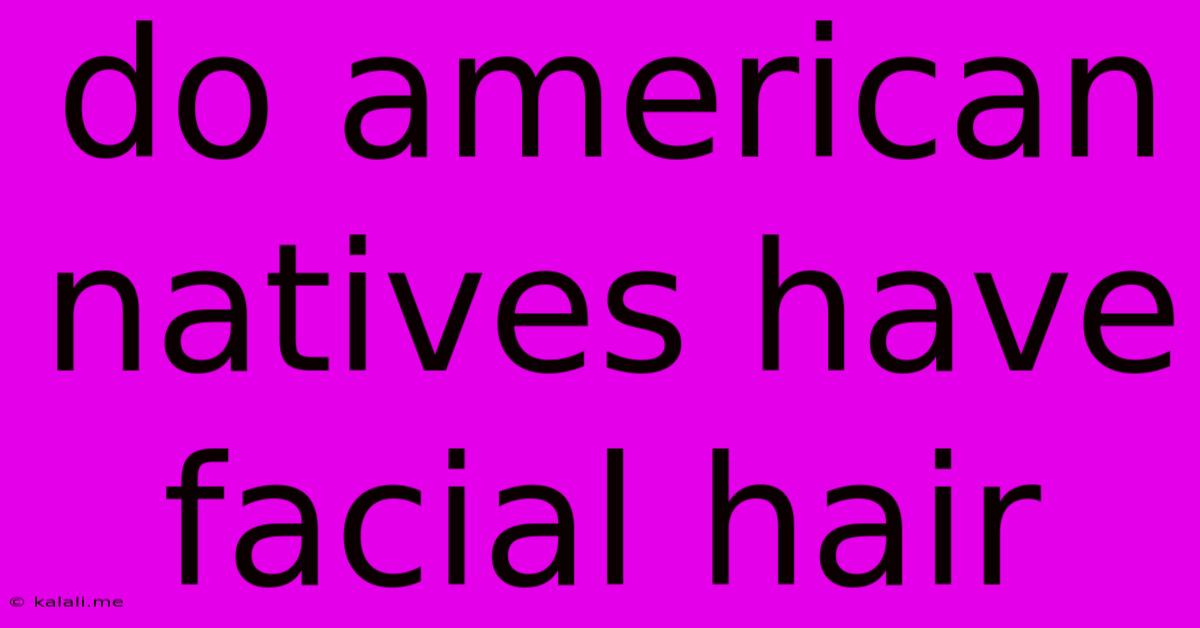Do American Natives Have Facial Hair
Kalali
May 21, 2025 · 3 min read

Table of Contents
Do Native Americans Have Facial Hair? Exploring the Myths and Realities
Meta Description: Discover the truth behind the common misconception about Native American facial hair. This article explores the diverse range of facial hair growth among Indigenous populations across the Americas, debunking stereotypes and highlighting the genetic and cultural factors at play.
The question of whether Native Americans have facial hair is a complex one, often clouded by historical inaccuracies and stereotypical portrayals. The short answer is: yes, some Native Americans have facial hair, while others do not. The amount and type of facial hair varies significantly depending on individual genetics, tribal affiliation, and even the specific family lineage. A blanket statement claiming all or none have facial hair is simply untrue and perpetuates harmful stereotypes.
The Myth of the "Hairless Indian"
The persistent myth of the hairless Native American is rooted in centuries of inaccurate depictions and biased reporting by European colonizers. These early accounts often selectively focused on individuals lacking significant facial hair, ignoring the diversity present within Indigenous populations. This bias further solidified the misconception and contributed to a skewed understanding of Native American physical characteristics. Such portrayals reinforced negative stereotypes and marginalized the true diversity of Indigenous appearances.
Genetic Diversity and Facial Hair Growth
Facial hair growth, like many other physical traits, is influenced by genetics. There's no single gene that determines facial hair presence or absence in any population group, including Native Americans. Genetic variations within and between Indigenous groups across North and South America contribute to the wide range of facial hair patterns observed. Just as there's a spectrum of hair color, eye color, and height within any population, there's also a spectrum of facial hair growth.
Cultural Practices and Facial Hair
While genetics play a significant role, cultural practices have also shaped perceptions of facial hair within different Native American tribes. Historically, some tribes valued specific forms of body adornment, including facial hair styling, while others may have preferred a cleaner-shaven look. These traditions varied widely depending on cultural beliefs, spiritual practices, and social status. The absence of significant facial hair in some historical accounts may simply reflect cultural preferences and grooming habits, not a lack of genetic potential for growth.
Modern Perspectives and Challenging Stereotypes
Today, it’s crucial to acknowledge and challenge the historical inaccuracies surrounding Native American facial hair. The diversity within Indigenous populations is vast, and generalizations about physical characteristics should be avoided. Understanding the genetic basis for facial hair growth and recognizing the influence of cultural practices help dispel harmful stereotypes and promote a more accurate representation of Native American communities.
Conclusion: Embracing Diversity and Challenging Misconceptions
The question of whether Native Americans have facial hair is not a simple yes or no answer. The wide range of facial hair growth among Indigenous people across the Americas is a testament to the inherent diversity within these populations. By understanding the genetic factors and acknowledging the historical inaccuracies surrounding this topic, we can work towards a more accurate and respectful portrayal of Native American communities. It's vital to remember that every individual is unique, regardless of their ethnicity or ancestry.
Latest Posts
Latest Posts
-
Is The Tap Water In Spain Safe To Drink
May 21, 2025
-
How To Clean Glue Off Tiles
May 21, 2025
-
Can Goldfish Live In A Pond Without A Pump
May 21, 2025
-
Can I Tow An Automatic Car
May 21, 2025
-
Kitchen Sink Blocked Past U Bend
May 21, 2025
Related Post
Thank you for visiting our website which covers about Do American Natives Have Facial Hair . We hope the information provided has been useful to you. Feel free to contact us if you have any questions or need further assistance. See you next time and don't miss to bookmark.